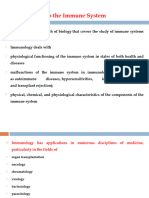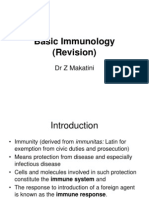Kuliah Biokimia-Imunokimia FK UNDIP
Kuliah Biokimia-Imunokimia FK UNDIP
Uploaded by
Putri HapsariCopyright:
Available Formats
Kuliah Biokimia-Imunokimia FK UNDIP
Kuliah Biokimia-Imunokimia FK UNDIP
Uploaded by
Putri HapsariCopyright
Available Formats
Share this document
Did you find this document useful?
Is this content inappropriate?
Copyright:
Available Formats
Kuliah Biokimia-Imunokimia FK UNDIP
Kuliah Biokimia-Imunokimia FK UNDIP
Uploaded by
Putri HapsariCopyright:
Available Formats
santoso
Traditional : protection from diseases and more
specifically, infections disease. Modern : a reaction to foreign substances, including microbes as well as macromolecules such as proteins and polysaccharides, without implying a physiologic or pathologic consequence of such a reaction.
Immune system : the cells and molecules
responsible for immunity Immune response : collective and coordinated response of immune system to introduction of foreign substances. Immunology : the study of immunity in this boarder sense and of the cellular and molecular events that occur after an organism encounters microbes and other foreign macromolecules.
Innate
Adaptive (specific)
Humoral
Cellmediated
Active
Passive
Limited capacity to distinguish one microbe from another Not only provide early defense against microbes, but also
plays several important roles in the induction of specific immune responses The principal components :
Physical barriers Blood proteins Phagocytic cells (neutrophils, macrophages) and other
leukocytes (NK)
Exquisite specificity for distinct moleculs
Specialization, which enables to respond in
particular ways to different types of microbes Ability to remember and respond more vigorously to repeated exposures to the same microbes
Specificity Diversity Memory Specialization Self-limitation Discrimination of self from non-self
Immune response are specific for distinct antigens
The portions of such antigens that are specifically
recognized by individual lymphocytes are called determinants or epitopes
The total number of antigenic specificities of the
lymphocytes in an individual, called the lymphocyte repertoire, is extremely large. At least 109 distinct antigenic determinants
Exposure of the immune system to a foreign antigen
enhances its ability to respond again to that antigen Response to second and subsequent exposures to the same antigen called secondary immune response are usually more rapid, larger, and often qualitatively different from the first or primary immune response to that antigen
The immune system responds in distinct and special
ways to different microbes Such adaptation have developed to maximize the efficiency of anti microbial defense mechanismes
All normal immune responses wane with time after
antigen stimulation This is largely because immune response function to eliminate antigens and thus eliminate the essential stimulus for lymphocyte activation.
Immune system able to recognize, respond to and
eliminate many foreign (non-self) antigensfunctional inactivation of self-reactive lymphocytes after their encounter with self antigens while not reacting harmfully to that individuals own (self) antigenic substances Immunologic unresponsiveness is also called tolerance Maintaned partly by the elimination of lymphocytes that may express receptors specific for antigenss and partly by
Recogniton Activation Effector
Cytokines
Effector mechanims of T cell- mediated immune
reactions Effector mechanisms of immunoglobulin E-initiated immune reactions The complement system
Compises a group of more than 30 serum and
cell surface proteins that interact with other immune system molecules and with one another in a highly regulated manner to provide many of the effector functions of humoral immunity and inflamation.
Mengakibatkan osmotic lysis pada bakteri Opsonisasi Reaksi inflamasi Kemotaksis Menghilangkan kompleks imun
Mediate cytolysis
Opsonization of foreign organisms or particles
Activation of inflamation Promotes solubilization and phagocytic clearance of
immune complexes Promote humoral immune response
You might also like
- New Holland MC22 MC28 MC35 Commercial Mower Service Repair ManualDocument21 pagesNew Holland MC22 MC28 MC35 Commercial Mower Service Repair ManualggjjjjotonesNo ratings yet
- CMLT 2018 MicrobiologyDocument53 pagesCMLT 2018 Microbiologyalvinjay4040No ratings yet
- Kolawole Taiye Sodeeq PresentDocument13 pagesKolawole Taiye Sodeeq PresentAbubakarNo ratings yet
- Phases of Adaptive Immune ResponseDocument46 pagesPhases of Adaptive Immune ResponseArshia NazirNo ratings yet
- Tugas ImunilogiDocument3 pagesTugas Imunilogilapalo46No ratings yet
- Immune ResponsesintissueDocument22 pagesImmune ResponsesintissueFahim AhmadNo ratings yet
- Lecture 1Document40 pagesLecture 1samanarshad438No ratings yet
- 4 Immune DisordersDocument11 pages4 Immune DisorderscedonuliNo ratings yet
- Chapter 6 - Diseases of The Immune SystemDocument3 pagesChapter 6 - Diseases of The Immune SystemArun Kumar SinghNo ratings yet
- Introduction To Immunology Lecture IDocument48 pagesIntroduction To Immunology Lecture IEsra Nur ELMASNo ratings yet
- Lec 11مناعة الرشيدDocument7 pagesLec 11مناعة الرشيدتجربة أولىNo ratings yet
- Immune System (IDK)Document40 pagesImmune System (IDK)DhnrawNo ratings yet
- Chap01 PDFDocument5 pagesChap01 PDFkaram BarakatNo ratings yet
- Zoology6thSem PDFDocument88 pagesZoology6thSem PDFRouf MalikNo ratings yet
- ImmunityDocument31 pagesImmunityFahad NiazNo ratings yet
- Vi Disease of The Immune System-7150Document44 pagesVi Disease of The Immune System-7150rizwanasalim3002No ratings yet
- Introduction To ImmunologyDocument3 pagesIntroduction To ImmunologyJohn Rick OrineNo ratings yet
- L1 - IntroductionDocument5 pagesL1 - IntroductionMiles NsgNo ratings yet
- Lecture 1 Introduction, Innate ImmunityDocument29 pagesLecture 1 Introduction, Innate Immunityanuja maliNo ratings yet
- Lecture 58-64Document6 pagesLecture 58-64Qᴜʀᴀᴛ Uʟ AɪɴNo ratings yet
- NIH Public Access: Author ManuscriptDocument41 pagesNIH Public Access: Author ManuscriptJuan Sebastian Villamil CañasNo ratings yet
- Properties and Overview of Immune ResponsesDocument30 pagesProperties and Overview of Immune ResponsesVivien KasimNo ratings yet
- IMMUNITYDocument39 pagesIMMUNITYsmithdibyenduNo ratings yet
- An Introduction To Immunology and ImmunopathologyDocument11 pagesAn Introduction To Immunology and ImmunopathologyImelda Lorenzette ArañaNo ratings yet
- Section 2 ImmunologyDocument14 pagesSection 2 ImmunologyricardoNo ratings yet
- RHE 216 IMMUNITY AND IMMUNIZATION BDocument26 pagesRHE 216 IMMUNITY AND IMMUNIZATION Babubakarahama449No ratings yet
- Immunology: Combined Class (Mental Health Psichatry, Clinical Anastasia, & Clinical Sciences) Year 2 30/03/2022Document30 pagesImmunology: Combined Class (Mental Health Psichatry, Clinical Anastasia, & Clinical Sciences) Year 2 30/03/2022Derick NKANDU KALUBANo ratings yet
- Immune System ProjectDocument21 pagesImmune System ProjectAvinash BobadeNo ratings yet
- Immunology and ImmunityDocument37 pagesImmunology and Immunityrahulyuva18No ratings yet
- The Immune Response: Anca Bacârea, Alexandru SchiopuDocument36 pagesThe Immune Response: Anca Bacârea, Alexandru Schiopukalaivani100% (1)
- M.10 Performing Serological TestsDocument71 pagesM.10 Performing Serological TeststesfayegujiNo ratings yet
- Basic Immunology 2Document66 pagesBasic Immunology 2JabbarTapiheruNo ratings yet
- Adaptive and Innate ImmunityDocument63 pagesAdaptive and Innate ImmunitySarvesh Patil100% (1)
- Types of Immunity: Prof. Dr. Payman A.HamaseedDocument17 pagesTypes of Immunity: Prof. Dr. Payman A.Hamaseedasia groupNo ratings yet
- Veterinary ImmunologyDocument271 pagesVeterinary ImmunologySam Bot100% (1)
- L07: The Immune System and The Diseases of The Immune SystemDocument10 pagesL07: The Immune System and The Diseases of The Immune Systemhstest842No ratings yet
- Immune SystemDocument8 pagesImmune Systemamenmiracle701No ratings yet
- CH 1. Overview of The Immune SystemDocument23 pagesCH 1. Overview of The Immune SystemIbrahim M100% (1)
- Key Elements of Immunity: SpecificityDocument9 pagesKey Elements of Immunity: SpecificityParth KulkarniNo ratings yet
- Basic Immunology (Revision) : DR Z MakatiniDocument51 pagesBasic Immunology (Revision) : DR Z MakatiniEstee van WykNo ratings yet
- Aminoden Immunology Activity 1 2021Document3 pagesAminoden Immunology Activity 1 2021hanzala macabandoNo ratings yet
- GBIO2 Q4 Mod4 FinalDocument12 pagesGBIO2 Q4 Mod4 Finalargiecasas08No ratings yet
- The Immune System: Liceo Bicentenario Diego Portales P. English Department CalamaDocument7 pagesThe Immune System: Liceo Bicentenario Diego Portales P. English Department CalamaHydregon DestinyNo ratings yet
- مناعة 1Document28 pagesمناعة 1hussein.al-bohaija.nurs1765No ratings yet
- Adaptive Immune Response: DR Zahraa A Mohammed 2024Document21 pagesAdaptive Immune Response: DR Zahraa A Mohammed 2024yara73832No ratings yet
- Introduction To Immunology and Immune SystemDocument10 pagesIntroduction To Immunology and Immune SystemDr.Kedar Karki ,M.V.Sc.Preventive Vet.Medicine CLSU Philippines100% (3)
- Immunology TodayDocument71 pagesImmunology Today7tn5g5dx9mNo ratings yet
- Module 12Document12 pagesModule 12mirai desuNo ratings yet
- Micp Lec (Week - 4) Host Response To InfectionDocument15 pagesMicp Lec (Week - 4) Host Response To Infectioncaitie miracleNo ratings yet
- Management For Immune Defense: Taghreed Hamza HawswiDocument39 pagesManagement For Immune Defense: Taghreed Hamza HawswiRani AlfiyyahNo ratings yet
- Microbiology L10 Immunity and Immune SystemDocument9 pagesMicrobiology L10 Immunity and Immune SystemephotomathNo ratings yet
- Organization of Immune SystemDocument44 pagesOrganization of Immune SystemSaubie AslamiahNo ratings yet
- 1 Imm A What Is ImmunityDocument12 pages1 Imm A What Is ImmunityroshnayimNo ratings yet
- Presentation GruopDocument6 pagesPresentation GruopXuseen CabdullahiNo ratings yet
- Immune System of HumanbodyDocument49 pagesImmune System of Humanbodysayan27.sikdarNo ratings yet
- Basic Immunology: Dr. Fitriyah Mayorita, SP - PKDocument46 pagesBasic Immunology: Dr. Fitriyah Mayorita, SP - PKFadhila RizkiNo ratings yet
- ImmunologyDocument59 pagesImmunologyImran KhanNo ratings yet
- Ch. 2 and 12: Students LecturesDocument17 pagesCh. 2 and 12: Students LecturesBasma RagabNo ratings yet
- Chapter 25 BioDocument11 pagesChapter 25 Biosgangwar2005sgNo ratings yet
- Prologue Syllabus 2008Document14 pagesPrologue Syllabus 2008Francisco Eriberto de LimaNo ratings yet
- International Mining FMS Report May 2020Document10 pagesInternational Mining FMS Report May 2020Jorge AzpilcuetaNo ratings yet
- Rolls-Royce M250-C20R SERIES OPERATION AND MAINTENANCE 720000 - 7Document12 pagesRolls-Royce M250-C20R SERIES OPERATION AND MAINTENANCE 720000 - 7anony8103No ratings yet
- Downhole Hydraulic IDocument67 pagesDownhole Hydraulic ImouradbzNo ratings yet
- Foundation and FootingDocument6 pagesFoundation and FootingMark SanchezNo ratings yet
- Carriers InfoDocument19 pagesCarriers InfoSharyar MalikNo ratings yet
- Carnival 2006 2.9 D Z-C EDocument15 pagesCarnival 2006 2.9 D Z-C ERinto Silalahi100% (2)
- Okaya SMF VRLA CatalogueDocument8 pagesOkaya SMF VRLA CatalogueSapna GuptaNo ratings yet
- ISCAID Guidelines For The Diagnosis and Management of Bacterial Urinary Tract Infections in Dogs and CatsDocument18 pagesISCAID Guidelines For The Diagnosis and Management of Bacterial Urinary Tract Infections in Dogs and Cats沈冠廷No ratings yet
- Annexure A MAXDocument2 pagesAnnexure A MAXrittechNo ratings yet
- كيمياء كامل محلولDocument321 pagesكيمياء كامل محلولAlhadaeel JesjNo ratings yet
- WEEk 6 - Topic Sentence, Supporting Sentence, Concluding SentenceDocument12 pagesWEEk 6 - Topic Sentence, Supporting Sentence, Concluding SentenceAZKIA FIL HIDAYAH100% (1)
- Causes of Individual SuccessDocument3 pagesCauses of Individual SuccessMariamNo ratings yet
- All Census 1951-2011 Latest Questions Asked in 2022 ExamsDocument6 pagesAll Census 1951-2011 Latest Questions Asked in 2022 ExamsBasani Ajay kumarNo ratings yet
- Voltage Sag Analysis Case Studies: JonesDocument7 pagesVoltage Sag Analysis Case Studies: JonesJofred Dela VegaNo ratings yet
- Standards Interventional Cardiovascular Nursing Practice 2017Document40 pagesStandards Interventional Cardiovascular Nursing Practice 2017Sean WingNo ratings yet
- Implementation of Eurocodes in SingaporeDocument18 pagesImplementation of Eurocodes in Singaporelimegreens100% (1)
- A Project Report OnDocument27 pagesA Project Report OnNeeraj JoshiNo ratings yet
- Introduction To Soil Mechanics and FoundationsDocument64 pagesIntroduction To Soil Mechanics and FoundationsElmer RoseteNo ratings yet
- Electrolysis Mind MapDocument1 pageElectrolysis Mind MapThomas BudiartoNo ratings yet
- Updates On The Treatment of Pterygium: Serbian Journal of Experimental and Clinical Research September 2016Document7 pagesUpdates On The Treatment of Pterygium: Serbian Journal of Experimental and Clinical Research September 2016Arfadin YusufNo ratings yet
- Bai Tap Ngu PhapDocument5 pagesBai Tap Ngu PhapNT Mỹ HạnhNo ratings yet
- Application of Kailin Ceramic Foundry Sand in Shell Method CastingDocument12 pagesApplication of Kailin Ceramic Foundry Sand in Shell Method CastingKaarthicNatarajanNo ratings yet
- ANTHE-2020 - (VIII Moving To IX)Document11 pagesANTHE-2020 - (VIII Moving To IX)ASNo ratings yet
- Consolidated Cases in Labor LawDocument827 pagesConsolidated Cases in Labor LawNewCovenantChurchNo ratings yet
- Equation Solvers: - ScilabDocument22 pagesEquation Solvers: - ScilabMita VegaNo ratings yet
- User's Manual of Electromagnetic Flow MeterDocument30 pagesUser's Manual of Electromagnetic Flow MeterAgustantoNo ratings yet
- BA BT300 DLT1201 18 aEN 014Document208 pagesBA BT300 DLT1201 18 aEN 014Banu EdoNo ratings yet
- Post Basic B.SC Nursing Entrance Exam 2015Document40 pagesPost Basic B.SC Nursing Entrance Exam 2015Manu CvNo ratings yet
- Warehouse Operations Manual Final Clean Copy 2Document118 pagesWarehouse Operations Manual Final Clean Copy 2Jose Martin BelarmaNo ratings yet

























































































